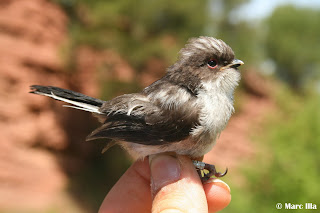June is, probably, the most boring month of the year when we talk about birds. All breeders are busy with their eggs or chicks and you only can rest waiting for some non-breeders, juveniles in dispersion movements, last prenuptial or early postnuptial migrating birds. Here in Catalonia, the second week of June is probably the 'worst' one, but suddenly: the turning point.
In an absolutely normal place like my local patch, a very small wetland inland Catalonia and surrounded by dry lands, something strange occurs every year. Some 'scarce' summer visitors appear, and this means an exceptional unpredictability. It's something like a migration period, but without (or only a few) migrating birds. They are just non-breeders, young birds or sometimes first postnuptial migrating birds moving south.
This situation makes special journeys, with totally unexpected birds at the same time you can see local birds breeding. Last week, for me, I reached the turning point of the year. A Whiskered Tern (Chlidonias hybridus) appeared in active migration, and only 4 days ago, a non-breeder Kingfisher (Alcedo atthis), a juvenile Purple Heron (Ardea purpurea) and an adult Eleonora's Falcon (Falco eleonorae). Also, 8 migrating Black-winged Stilts (Himantopus himantopus), a Green Sandpiper (Tringa ochropus), a Black-crowned Night Heron (Nycticorax nycticorax) and a male Hawfinch (Coccothraustes coccothraustes) (this one the rarest sighting; it's the fist time this species is observed there!!) the following day. Two days ago, the Eleonora's Falcon was still there and I saw a male Little Bittern (Ixobrychus minutus) too... an yesterday a non-breeder Green Woodpecker (Picus viridis), a 1cy Turtle Dove (Streptopelia turtur) and a probably migrating Little Ringed Plover (Charadrius dubius). All this species are very scarce here, also in migration.
However, ringing sessions continue meaning local breeders and lots of chicks. I'm quite entertained with some juvenile Goldfinches (Carduelis carduelis), trying to guess their sex.

Another nice pastime is ringing House Martins (Delichon urbicum), that come to drink some water in a fantastic place to put a mistnet.

This water point also attract birds like Rock Sparrows (Petronia petronia) and Crested Larks (Galerida cristata), that comes to drink something in order to resist the summer temperatures.



This two species can seem a little bit boring when we talk about their plumage colours and feathers. But Crested Larks have the curious crest, and Petronias hide two secrets more.




In an absolutely normal place like my local patch, a very small wetland inland Catalonia and surrounded by dry lands, something strange occurs every year. Some 'scarce' summer visitors appear, and this means an exceptional unpredictability. It's something like a migration period, but without (or only a few) migrating birds. They are just non-breeders, young birds or sometimes first postnuptial migrating birds moving south.
This situation makes special journeys, with totally unexpected birds at the same time you can see local birds breeding. Last week, for me, I reached the turning point of the year. A Whiskered Tern (Chlidonias hybridus) appeared in active migration, and only 4 days ago, a non-breeder Kingfisher (Alcedo atthis), a juvenile Purple Heron (Ardea purpurea) and an adult Eleonora's Falcon (Falco eleonorae). Also, 8 migrating Black-winged Stilts (Himantopus himantopus), a Green Sandpiper (Tringa ochropus), a Black-crowned Night Heron (Nycticorax nycticorax) and a male Hawfinch (Coccothraustes coccothraustes) (this one the rarest sighting; it's the fist time this species is observed there!!) the following day. Two days ago, the Eleonora's Falcon was still there and I saw a male Little Bittern (Ixobrychus minutus) too... an yesterday a non-breeder Green Woodpecker (Picus viridis), a 1cy Turtle Dove (Streptopelia turtur) and a probably migrating Little Ringed Plover (Charadrius dubius). All this species are very scarce here, also in migration.
However, ringing sessions continue meaning local breeders and lots of chicks. I'm quite entertained with some juvenile Goldfinches (Carduelis carduelis), trying to guess their sex.

Another nice pastime is ringing House Martins (Delichon urbicum), that come to drink some water in a fantastic place to put a mistnet.

 |
| This bird had an injured foot, with an ant's head! |

 |
| Typical 'in hand Alaudidae posture'. |


This two species can seem a little bit boring when we talk about their plumage colours and feathers. But Crested Larks have the curious crest, and Petronias hide two secrets more.


This 2cy female White Wagtail (Motacilla alba) also came to the pond.

At the same time, a few breeders are already thinking about migration. This Nightingale (Luscinia megarhynchos) was a female with broodpatch, but she had started her complete postnuptial moult.
Other birds prefer to breed successively until the summer ends. The most spectacular case is the Zitting Cisticola (Cisticola juncidis), the only european passerine able to breed just before fledging... This female was a first-year bird, that probably flew for first time a couple of months ago, and had a well-developped broodpatch that indicate this bird is breeding.

Finally, the 'family photo':
 |
| Left to right: Tree, House and Rock Sparrows. |






























